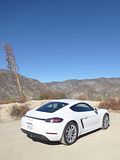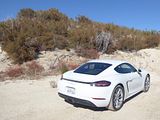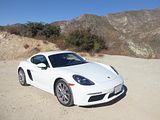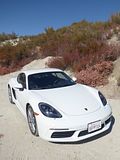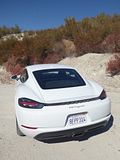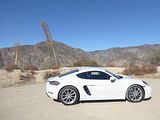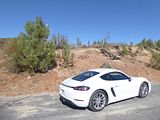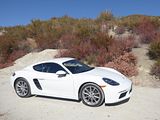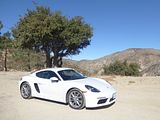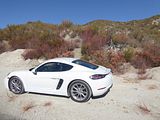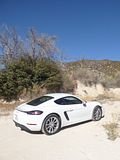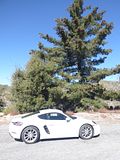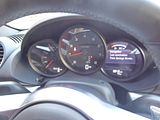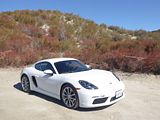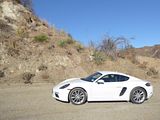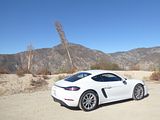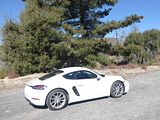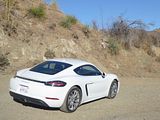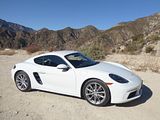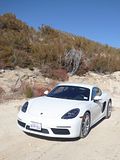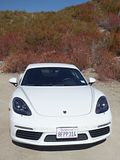Whilst the Cayenne is very much the car that keeps Porsche’s finance not just afloat but among the most profitable of all car manufacturers, it should not be forgotten that it was actually the introduction of the 986-generation Boxster back in 1996 which saved the company from what looked like financial ruin. A slightly smaller and more affordable stablemate to the long-running 911 was just what was needed to boost sales of the respected Stuttgart marque to previously unimaginable levels. Not long after the launch of the second generation, 987-series Boxster, rumours started to circulate of a new closed-roof coupe model being added to the range and the car duly arrived in late 2005, named the Cayman. It proved just as popular as the open-roofed model and ever since that time, Porsche have offered both Boxster and Cayman cars with the two models mirroring each other very closely. Officially, we are now on the fourth generation Boxster, known as the 982-series, though in reality this was more of a significant revamp of the 981 rather than an all-new model. Visually there were tweaks to the front and back, with a chrome finisher that goes through the rear lights and across the back of the car being the easiest recognition point, though in fact, just about every body panel was changed. Under the skin, much was changed, with new engines aimed at increasing efficiency and reducing emissions, though Porsche’s approach of replacing the existing 6-cylinder engines with higher output smaller capacity turbo 4s drew lots of comment and not much of it positive. There was also a subtle repositioning of the cars, with the Boxster moved in price point to be a little more costly than the closed coupe Cayman for the first time, a move which Porsche said would bring them into line with other manufacturers who charge more for an open-topped car than a closed one.
Hertz in the US have had a number of Porsche models on fleet for several years now. They started out with a series of Panamera cars but it was not long before they added all the other models in the range, with Cayenne and Macan SUVs joined by Boxster and Cayman models. Initially the rental costs were very high and although some people were prepared to pay what was asked, it was only by relaxing the mileage limit and offering deals when the parking lot was well supplied with them that they got more action. Once this happened, I systematically worked my way through each of the models, which was just as well, as over time, the number that Hertz had available seemed to reduce. The Panamera models all disappeared with the introduction of the second generation car and the Boxster and Cayman cars also went after the change from 981 to 982 series leaving just a few 911s and the Cayenne and Macan. But when I was in LA at the end of 2018, my friends there said that they had heard that a whole lot of 2019 model year cars were en route and sure enough, on the last day of that trip, I saw a few on site, newly plated up. There seemed to be a mix of 718 Boxster and Cayman cars, and all them were either black or white. I was able to secure one of the 718 Boxsters on my next trip in the Spring of 2019, and I enjoyed it very much. Clearly, I wanted to try the latest 718 Cayman as well, and the chance came on this November 2019 trip. The trick is to source a car during the week when there is less demand (business rentals dominate the bookings during the week), which meant I was able to secure this car for a surprisingly modest upgrade from what I had booked. I only had one day, but that would be enough to reacquaint myself with a car which I had enjoyed in its 981-generation format a few years earlier. Here is what I thought.
One of the most significant changes with the 982-generation of Cayman and Boxster was the replacement of the old flat six engines with smaller capacity high output four cylinder units. The entry level car, which is the spec of the test car, has a two litre turbo unit, which puts out 300 bhp, which is slightly more than was offered by the old 2.7 litre six cylinder unit. The critics may have said otherwise, but to my ears, the engine in this car still sounds great, especially on start-up and when under acceleration. It is not as good a sound as you got from the six cylinder unit of its 981-generation predecessor, but compared to a lot of cars, it can still excite. It would seem that the issues and complaints come when the engine is worked hard especially if the car has the sports exhaust system fitted, which was not the case with this one. Regardless of the controversy, there is no doubting the available performance, though. This car goes well, with strong acceleration not just from rest, but also from almost any speed. The red line is set to 7,600 rpm, and whilst the engine is willing all the way to this point, the noise does get louder and not necessarily in a good way as you get closer to the limit. But in every day drivig you won’t be able to do that given the limits of the law and traffic. The Cayman still has a manual gearbox as standard but there is the option of a 7 speed PDK unit, and this was fitted to my car. It is very smooth, moving between the gears with ease. There are paddles if you want to change the ratios yourself, though I found for the sort of driving I was doing, there was little to be gained by so doing. Once at a steady speed, on the freeway when the traffic cleared, noise levels were low, so this would be a peaceful cruiser, though there is a proviso I will come to. The Cayman features a stop/start system, which worked very efficiently and was helpful when crawling in the legendary LA morning rush hour traffic. I covered 182 miles during my day with the Cayman and it needed 5.75 gallons to fill it up. The trip computer said 33 mpg (US), though if you do the maths, it comes out at 31. 6mpg, which suggests the car was not quite as full when I collected it as it was when I returned it. That has to count as an excellent result. It is slightly better than what I achieved with the 718 Boxster, so I suspect is representative of what you could expect to achieve in everyday motoring.
Expectations were high that this 718 Cayman would be great to drive and it was, The steering is among the best you will ever come across. Perfectly weighted, very direct and with plenty of feel, it was a joy to steer the car, which was made even more enjoyable when I took to the bendy roads up in the hills. The cornering abilities of this car are utterly amazing. There is no body roll, seemingly limitless amount of grip and thanks to the life from the steering, this car was utter joy on every curvy road I found. And when it comes to needing to stop, the brakes were powerful and effective without needing to press them really hard. It’s not quite perfect, though, as the ride proved that it is not set up for every surface. The Cayman has differently sized wheels front and rear, being 235/40 ZR19 and 265/40 ZR19s respectively, which are larger than the standard 18 inch wheels on the entry level car. On some surfaces, all was good, but on the 405 freeway going up past Downtown LA, it was very pitchy indeed, in a way that virtually no other car I have driven on that road has proved to be. Worryingly, I know there are other roads in the State which are far more challenging even than that one. Up in the canyons, where the surfaces are pretty good, all was well. Visibility is not brilliant, either, as you rather expect from a small and low-set coupe. The mirrors do give a good field of view and there are front and rear park sensors to help with parking. The over the shoulder view was also not so good so care was needed at oblique junctions.
With the exception of switches for an opening roof which are not needed here, the interior of the 718 Cayman is the same as that of the 718 Boxster and both follow current Porsche form. That means that there is a very high quality look and feel to everything. There is lots of leather on the dashboard and the door casings and there is a metallised finisher on the dash and also around the gearlever. There is a chunky leather-wrapped steering wheel which was just the right thickness and was a delight to hold. The instrument cluster contains three overlapping dials, with a speedometer, rev counter and display area which contains the fuel gauge in the upper portion all right in front of the driver, and easy to read. There are no fewer than four column stalks and the two paddles for the gearbox, as Porsche have chosen not to put lots of buttons on the steering wheel boss. As well as indicators, the left hand side pair includes cruise control whilst on the right hand side as well as a wiper stalk there is one to select the digital display options and audio repeaters. The centre of the dash contains an integrated touch screen which is quite small but it has clear graphics and it proved easy to use, even though it does not have a control wheel like you find in iDrive or MMI. The system is not as functionally rich as you will find in some cars, and to many that will not matter (or they can reach for the options list!), but included in the functions is a Bose sound system which projects the audio selections including XM Satellite radio and there was the optional navigation system included. You do get Bluetooth and a couple of USB ports but Apple Car Play is on the options list. Beneath this unit are an array of buttons for the dual zone climate control, though I was little surprised to find that even this is optional. There are a lot of buttons in the centre console, which include those needed to select sport mode and to change the exhaust sound as well as to enable or disable the stop/start system. The electronic handbrake button is on the dash to the left of the wheel which is where you will also find the slot for the key to start the engine.
The Cayman is a strict two seater, which does mean that the doors are quite long, but the car is not tall, so getting in does call for a certain athleticism, and you may well find that it is harder to get out gracefully. Luckily, I am quite agile, and one advantage of being less tall than average means that there is less of me to get in through the available space without banging my head or indeed any other part of my anatomy. Once in, you will find there are two high-backed seats, wrapped in a nice quality leather. The cockpit is cozy but not confining. With the Cayman’s small size, it feels a bit as if you’re wearing the car rather than sitting in it, which is how a sports car should feel. The seats are electrically adjustable and there is a wide range of adjustment in every direction, so getting the driving position to suit should not be that hard. You do sit low, as you probably expect and hope for in a sports car. Once you’ve found the position you want there are two memory settings allowing you to store in case anyone else should move the seat around. The steering column is also electrically adjustable. There are seat heaters, though in California, even in late November, these were not something I needed to use or test out. The seat itself proved very comfortable and there is plenty of lateral support, which would hold you in position when you want to test out the handling.
The Cayman is more practical than you might imagine for a relatively small sports coupe. There are two separate boots, one at either end of the car. That in the front is deep enough that I would have been able to put my suitcase in, standing on its end (I found this out on previous tests of this family of Boxster and Cayman). It is regular in shape, so you could easily get in a couple of large bags here. The space at the back is smaller, but again there is a nice regular shaped area at the back of the car which would take a bag or two and flat-ish things and soft things would fit in here quite easily. There is not really any space behind the front seats but there are a couple of lidded cubbies over the rear wheels. For odds and ends in the cabin, there is a modestly sized glovebox, and some rather small bins on the doors which are accessed by pulling inwards the side cover and there is also a small cubby under the central armrest. There are cupholders, though those unfamiliar with the car may not find them, as they pop out from the trim above the glovebox.
The 2019 Porsche 718 Cayman is a two-seat coupe available in Cayman, Cayman S and Cayman GTS trim levels, matching equivalent versions of the 718 Boxster. The entry level Cayman has a turbocharged 2.0-litre horizontally opposed four-cylinder engine (a flat-four) producing 300 bhp and 280 lb/ft of torque. The Cayman S has a turbocharged 2.5-litre flat-four good for 350 bhp and 309 lb/ft. The Cayman GTS uses this engine but bumps power output to 365 bhp. A six-speed manual transmission is standard across the board, though a seven-speed, dual-clutch automatic transmission (Porsche’s PDK) is optional. Standard features on the 718 Cayman include 18-inch wheels, performance summer tyres, xenon headlights, LED running lights, heated mirrors, front and rear parking sensors, automatic climate control, a rearview camera, six-way adjustable seats (power recline, manual height and slide), a tilt-and-telescoping steering wheel, partial leather upholstery, a 7-inch touchscreen, two USB ports, and an eight-speaker audio system with a CD/DVD player and HD and satellite radio. The 718 Cayman S only differs in its larger, more powerful engine, 19-inch wheels and dual exhaust pipes. The 718 Cayman GTS slightly increases the power output and adds unique front and rear fascias, a faux-suede-wrapped steering wheel and leather/faux-suede combination upholstery. It also adds a few features that are optional on the above models, including 20-inch wheels, a sport exhaust system with black-painted tailpipes, Porsche Torque Vectoring (a brake-based differential), and Porsche Active Suspension Management (PASM), which adds adaptive dampers and lowers the ride height by 10mm. Also included is the Porsche Sport Chrono package, which provides dynamic transmission mounts, a digital and analog stopwatch mounted atop the dash, a driving mode switch on the steering wheel, launch control (for PDK models), an additional performance display, and a Sport response button that sharpens engine and transmission response for 20 seconds. Like every Porsche, the options list is extensive, allowing for a great deal of customization. Performance add-ons include a selection of 19- and 20-inch wheels, a steering upgrade for lighter low-speed effort and ceramic-composite brakes. The Cayman S and GTS are also eligible for a PASM system that lowers the ride height by 20mm. Comfort and convenience options include adaptive headlights, LED adaptive headlights, headlight washers, auto-dimming mirrors, a rear window wiper, power-folding mirrors, adaptive cruise control, blind-spot monitoring, keyless entry and ignition, dual-zone automatic climate control, heated and ventilated seats, 14-way power-adjustable seats, upgraded seats with more aggressive bolstering and either manual or power adjustments, several types of upgrade leather and upholstery, a navigation system, Apple CarPlay, a 10-speaker Bose audio upgrade, and a 12-speaker premium Burmester audio system.
No question, the 982 Cayman is an excellent car. It is everything you would expect a small sports car to be. It goes well, stops well, and handles brilliantly, so it is really fun to drive and it is not too big for increasingly crowded roads, so you can park it easily and take it on narrower country roads without fearing what might happen when you meet oncoming traffic. It is beautifully built and is comfortable inside that compact cabin and is more practical for two people and their luggage than you might expect. In entry level spec, whilst not cheap, it is not outrageously priced and these cars do hold their value well. So, all pretty good, If you’d not driven a six cylinder car, you’d have little to complain about. And if you have, well, the price of progress is an engine which on the limit is not quite as good as what went before, but it is still pretty agreeable. I commend this as one of the “best” cars on the market at present. If you get the chance to drive one, you really should.

































